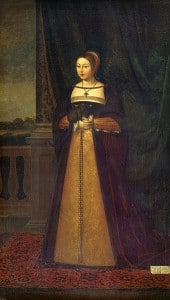
Margaret spent her childhood at Sheen and at Eltham Palace, but was sent to Scotland at the age of thirteen to marry James IV following the 1502 Treaty of Perpetual Peace between England and Scotland. Margaret and James had been married by proxy on 25th January 1503 at Richmond Palace but married in person on 8th August 1503 at Holyrood Abbey.
James IV and Margaret Tudor went on to have six children, including the future James V of Scotland, father of Mary Queen of Scots. James IV died at the Battle of Flodden in 1513, a battle between Scotland and Margaret’s brother Henry VIII’s forces. For a time, Margaret acted as Regent and although she had opposition, being the enemy’s sister, she managed to reconcile Scotland and England. Things changed, however, when Margaret secretly married Archibald Douglas, 6th Earl of Angus, a member of the powerful Scottish House of Douglas. When the news got out, Margaret encountered opposition from the nobles and in September 1514 the Privy Council ruled that she had acted against the terms of James IV’s will and could no longer act as Regent. She was replaced by John Stewart, 2nd Duke of Albany, who took custody of her sons, James and Alexander, keeping them at Stirling Castle.
In 1515 a now pregnant Margaret and her husband fled across the border into England and were taken in by Lord Dacre, Warden of the Marches. At Harbottle Castle, Northumberland, on 8th October 1515, Margaret gave birth to a little girl who would become Lady Margaret Douglas, mother of Henry Stuart, Lord Darnley. In December 1515, Margaret learned of the death of her son Alexander, Duke of Ross, which must have been devastating news. There was more bad news to come – her husband, Archibald, abandoned her return to Scotland and make peace with Albany and escape a charge of treason. Margaret didn’t look back; she continued her journey on to London where her brother, Henry VIII, arranged lodgings for her at Scotland Yard in Whitehall.
In July 1516, Albany and Cardinal Wolsey negotiated a treaty of between Scotland and England which made it possible for Margaret to return to Scotland in 1517. There, she found out that her husband had been living with another woman, Lady Jane Stewart, while she had been away in England. Although the couple were, at first, reconciled, Margaret decided that she wanted to divorce her husband. She sought Henry VIII’s help, but he was unwilling to make an enemy of his brother-in-law and did not believe in divorce. Margaret was forced to seek help from Albany, instead, and it was he who convinced Pope Clement VII to grant Margaret’s petition for a divorce, which he did in March 1527.
On 3rd March 1528, Margaret married her third husband, Henry Stewart. Unfortunately, the marriage was not a happy one and Margaret sought a divorce following her husband’s infidelity. This time, she was unsuccessful in her quest for her divorce because her son, King James V, who was now ruling in his own right, did not support it. Margaret was later able to reconcile with her husband and the King created Stewart Lord Methven and gave the couple Methven Castle in Perthshire.
On the 12th June 1538, James V married Mary of Guise by proxy, and when Mary arrived in Scotland she and Margaret became great friends. The couple had three children – two sons and a daughter – but only the daughter, Mary, survived infancy. She, of course, became Mary, Queen of Scots.
Margaret died on the 18th October 1541 at her home, Methven Castle, following a stroke. She was laid to rest at the Carthusian Priory of St John in Perth, which was later destroyed. It was Margaret’s great-grandson, King James VI of Scotland, who became king on the death of Margaret’s niece, Elizabeth I, on 24th March 1603. He united Scotland and England and began a new royal dynasty in England, the House of Stewart, but he had Tudor blood so the Tudor line continued.
